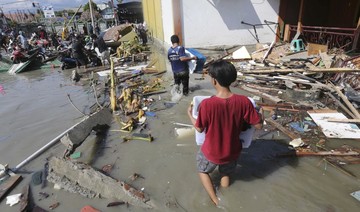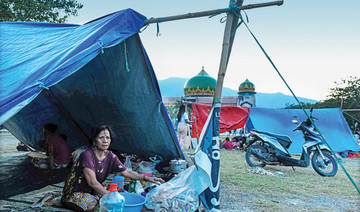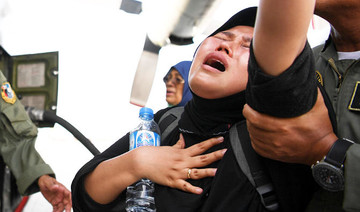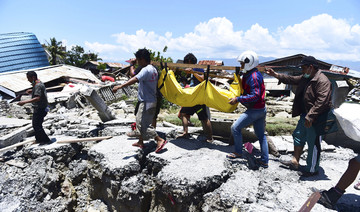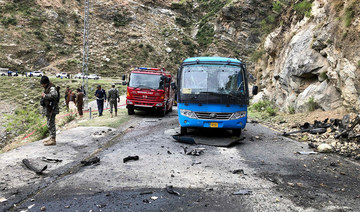JAKARTA: Captain pilot Ricosetta Mafella knew something was wrong in Palu but had no idea that what he felt on the runway and what he saw along the coast of Palu and Donggala in Central Sulawesi province was a 7.4-magnitude earthquake, which triggered a tsunami.
The Batik Air flight 6231 with 148 people on board was rolling on the runway when he sensed an unusual rocking movement during the last seconds before he took off at 6:02 p.m. local time from Mutiara Sis Al Jufri airport.
“I asked permission from the air traffic controller to take off and the tower responded: 'Batik Air 6231 runway 33 clear for take off.' When I reached 1,500 feet altitude, I contacted the tower again but there was no response,” Mafella told Arab News.
“As I took off, I looked out of the window and saw something strange happening on the sea along the coast of Palu and Donggala. There were about five large round white waves forming a row along the coast. I had no idea what they were. Something strange was happening but I tried to think positively.”
As he flew higher to 8,000 feet, he saw there were already about eight round, white waves with a radius that kept getting longer.
“It was like a row of white plates you put on a table, but in reality they were really large, round waves on the sea. I saw them all during seven minutes after we took off and before we changed our direction,” he said.
When the flight arrived in Makassar, South Sulawesi province, an hour later, he learned that a powerful earthquake and a tsunami had hit Palu and the “white plates” he saw on the sea were rolling waves that had formed owing to submarine landslides caused by the quake.
“Apparently those were the initial waves that later turned into a tsunami,” he said, adding that it was a breathtaking sight he could never forget.
He also learned that the air traffic controller who gave clearance for his flight to take off, Anthonius Gunawan Agung, had died from internal injuries and broken legs after jumping off the tower that was swaying in the quake.
“When he didn’t respond after I called him again at 1,500 feet high, I thought he was taking a break,” Mafella said.
The pilot described Agung as his “guardian angel” for keeping him and the other 147 people on board safely airborne, and dedicated a “wing of honor” to him.
Meanwhile, down in the coastal area of Palu, Suwarman Caco, a community neighborhood chief in Besusu Barat sub-district was sleeping in his house when the quake struck.
“The ground was shaking really hard. I was thrown here and there as I tried to get out of the house with my wife. My children and my grandchildren were nowhere to be seen,” Caco told Arab News, adding that he was reunited with them later in the evening at 11 p.m.
Since his house, which remains intact, is 300 meters away from Talize Beach, Caco said he didn’t see the tsunami but heard people screaming “Water, water, water!” 10 minutes after the tremor.
He estimated that more than 200 people from his neighborhood were on the beach as they were going to attend the opening of the Palu Nomoni Festival on the beach. The festival’s opening was scheduled for 8:30 p.m. and by the time the quake struck, people were already arriving.
Caco said that according to people who saw the tsunami, the dark-watered waves were seven meters high and swept the beach with a thundering sound within 10 minutes of the earthquake.
Five days after the twin disasters hit Palu and the neighboring districts of Donggala, Parigi Moutong and Sigi, the number of casualties has passed 1,000 and the number of people badly injured, missing and displaced has also risen.
National Disaster and Mitigation Agency spokesperson Sutopo Purwo Nugroho said at a press briefing on Tuesday that the number of people who have died in the disaster has reached 1,234, while there were now 799 injured, 99 still missing and 16,367 displaced.
“Some of the casualties have been identified through face recognition and their fingerprints, and they have been buried,” Nugroho said.
At least 65,733 houses are damaged but Nugroho said the authorities still can’t estimate the number of people buried in the rubble of houses on Petobo, Sigi district and Balaroa residential area in Palu, which was built not far from the Palu-Koro fault.
Indonesian pilot describes a strange sighting on the sea before tsunami hit Palu
Indonesian pilot describes a strange sighting on the sea before tsunami hit Palu
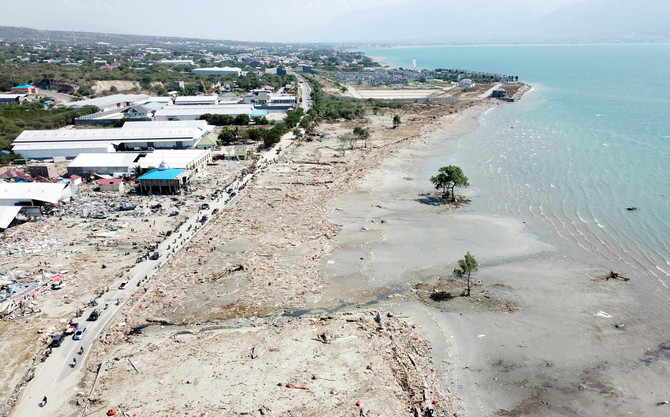
- The Batik Air flight 6231 with 148 people on board was rolling on the runway when it sensed an unusual rocking movement
- At 8,000 feet, pilot saw there were already about eight round, white waves with a radius that kept getting longer
Elon Musk confirms Twitter has become X.com

- Billionaire head of Tesla bought Twitter for $44 billion in late 2022 and announced rebrand to X last July
- Although the logo and branding were changed to “X,” the domain name remained Twitter.com until Friday
PARIS: The social network formerly known as Twitter has fully migrated over to X.com, owner Elon Musk said on Friday.
The billionaire head of Tesla, SpaceX and other companies bought Twitter for $44 billion in late 2022 and announced the rebrand to X last July.
Although the logo and branding were changed to “X,” the domain name remained Twitter.com until Friday.
“All core systems are now on X.com,” Musk wrote on X, posting an image of a logo of a white X on a blue circle.
Queries to Twitter.com redirected users to X.com on Friday morning, though the original domain name still appeared on some browsers.
Musk has repeatedly used the letter X in the branding of his companies, starting in 1999 with his attempt to set up an online financial superstore called X.com.
When he bought Twitter, he set up a company called X Corp. to close the deal.
Musk has said he wants “X” to become a super-app along the lines of China’s WeChat.
The Chinese app is much bigger than X and weaves together messaging, voice and video calling, social media, mobile payment, games, news, online booking and other services.
He has also bolted onto X an AI chatbot called “Grok,” which was launched in Europe this week.
Musk’s leadership of X has proved controversial.
He has fired thousands of staff, overseen major technical problems and reinstated accounts of right-wing conspiracy theorists, as well as former US president Donald Trump.
European regulators have also begun probes into X and other social media platforms over fears of misinformation.
The EU demanded earlier this month that X explain its decision to cut content moderation staff, giving the firm a deadline of Friday.
AFP has contacted X for their response.
Taliban supreme leader makes rare visit to Afghan capital

- Hibatullah Akhundzada gave a speech in front of the 34 provincial governors
- The appointment of officials on the basis of “favoritism or personal relationships” was also to be avoided
KABUL: The shadowy supreme leader of the Taliban authorities made a rare visit to Afghanistan’s capital, a government website said Friday, leaving his reclusive compound in Kandahar to meet with the country’s senior officials.
It comes after a string of small-scale clashes between farmers and Taliban anti-narcotic units tasked with destroying poppy fields, and flash floods that have killed hundreds.
Hibatullah Akhundzada gave a speech in front of the 34 provincial governors on Thursday at the Interior Ministry, the Taliban website Al Emarah said.
The leader emphasized “unity and harmony,” according to a summary of the speech posted to the website on Friday.
“Obedience was highlighted as a divine obligation,” it said, adding that the implementation of Islamic Sharia law and principles “should take precedence over personal interests.”
The appointment of officials on the basis of “favoritism or personal relationships” was also to be avoided.
Akhundzada, of whom only one photo has been publicly circulated, rarely appears in public, ruling by decree from a secretive compound in the southern city of Kandahar.
His cabinet, however, sits in the capital Kabul, from where they implement his decisions.
The purpose of the visit was likely about “enforcing internal discipline and unity,” a Western diplomat told AFP, adding that it could be motivated by the unrest in Badakhshan in eastern Afghanistan.
Witnesses reported that Taliban forces opened fire to disperse villagers protesting against poppy clearing — a lucrative crop banned by Akhundzada in April 2022.
Several people died in one of the clashes, a Taliban official said at the time.
The Afghan authorities have also had to repress demonstrations by settled nomads in the province of Nangarhar and are faced with regular deadly attacks from the Daesh group, particularly in Kabul.
“Whenever you see cracks or disagreements, then you have Kandahar stepping in reminding everyone and enforcing that (unity) as well,” the diplomat added.
After criticism, Spain museum alters name of Palestinian program

- The museum had controversially called the program “From The River To the Sea”
- Spain’s FCJE, an umbrella body representing the Jewish community, had denounced the original title of the program
MADRID: Madrid’s Reina Sofia museum said Thursday it had changed the name of a pro-Palestinian program that the Israeli embassy and the Jewish community said furthered a narrative calling for Israel’s extermination.
The museum, one of Spain’s most visited which is home to Pablo Picasso’s historic Guernica painting about the horrors of war, had controversially called the program “From The River To the Sea” — a rallying cry among Palestinians.
The term refers to the borders of the British Palestine mandate between the Jordan River and the Mediterranean Sea before Israel’s establishment in 1948. Some Jewish groups see it as calling for the destruction of Israel.
In a statement, the museum said it had renamed the program “Critical Thinking Gatherings, International Solidarity With Palestine” since the original name was considered “offensive to certain communities.”
The program includes lectures, conversations and meetings with Palestinian artists as well as two art installations, all aimed at demanding “an end of the war and genocide,” according to the museum’s website.
Spain’s FCJE, an umbrella body representing the Jewish community, had denounced the original title of the program.
“This slogan, considered anti-Semitic by the US House of Representatives, implies the elimination of Israel and its inhabitants... it also appears on maps at various rallies where Israel is erased,” it said in a statement.
Spain has been one of Europe’s most critical voices about Israel’s Gaza offensive and is working to rally other European capitals behind the idea of recognizing a Palestinian state.
The Gaza war began on October 7 when Hamas militants stormed across the border into southern Israel.
The unprecedented attack resulted in the deaths of more than 1,170 people, mostly civilians, according to an AFP tally of official Israeli figures.
Militants also seized about 250 hostages, 128 of whom Israel estimates remain in Gaza, including 36 the military says are dead.
Vowing to destroy Hamas, Israel launched a blistering retaliatory offensive that has killed more than 35,000 people, mostly women and children, according to the health ministry in Hamas-run Gaza.
Moroccan asylum-seeker gets life sentence for killing UK retiree in attack motivated by war in Gaza

- Judge Bobbie Cheema-Grubb sentenced Alid to life with no chance of parole for 45 years
- “The murder of Terence Carney was a terrorist act in which you hoped to influence the British government,” she said
LONDON: A Moroccan asylum-seeker who stabbed a British retiree to death in revenge for Israel’s war against Hamas was sentenced Friday to at least 45 years in prison for what the judge termed a terrorist act.
Ahmed Alid told police after his arrest that he’d killed 70-year-old Terence Carney in the northeast England town of Hartlepool because “Israel had killed innocent children.”
“They killed children and I killed an old man,” he said during questioning.
Prosecutors said that on Oct. 15 — eight days after the Hamas attack on Israel that triggered the war in Gaza — Alid attacked his housemate, Iranian asylum-seeker Javed Nouri, with a knife as he slept. Nouri survived. Alid then ran outside, encountered Carney having a morning walk and stabbed him six times.
Prosecution lawyer Jonathan Sandiford said Alid had told police that “if he had had a machine gun and more weapons, he would have killed more victims.”
Alid, 45, had denied the charges against him. Although he acknowledged stabbing the men, he said he had no intent to kill or cause serious harm.
A jury at Teesside Crown Court last month found Alid guilty of one count of murder, one count of attempted murder and two counts of assaulting police officers during his post-arrest interview.
Judge Bobbie Cheema-Grubb sentenced Alid to life with no chance of parole for 45 years, saying he had shown “no genuine remorse or pity” for his victims.
“The murder of Terence Carney was a terrorist act in which you hoped to influence the British government,” she said. “You hoped to frighten the British people and undermine the freedoms they enjoy.”
In a victim impact statement, the victim’s wife Patricia Carney said she could no longer go into town because it was “too painful” to be near the spot where her husband was murdered.
Nouri, a convert to Christianity, said the attack had destroyed his sense of safety.
“I would expect to be arrested and killed in my home country for converting to Christianity but I did not expect to be attacked in my sleep here,” his statement said. “How is it possible for someone to destroy someone’s life because of his religion?”
Slovak PM has new surgery, condition ‘still very serious’

- The Banska Bystrica hospital director said Fico remained “conscious” despite being in a “serious” condition
- “This is a lone wolf whose actions were accelerated after the presidential election since he was dissatisfied with its outcome,” Interior Minister Matus Sutaj Estok said
BRATISLAVA: Slovak Prime Minister Robert Fico’s condition was on Friday “still very serious” two days after an attempted assassination, his deputy and close ally said, as police raided the suspect’s home.
Fico was hospitalized after the shooting on Wednesday, which happened as the 59-year-old leader was speaking to members of the public after a meeting in the central town of Handlova.
“He was operated on again, he had an almost two-hour-long operation,” deputy prime minister Robert Kalinak told reporters outside the hospital in Banska Bystrica.
Fico had previously undergone a five-hour-long surgery, shortly after being airlifted from the scene of the attack on Wednesday.
“His state is still very serious. I think it would take a couple of days to see the course of the development of his state,” Kalinak added on Friday.
The Banska Bystrica hospital director said Fico remained “conscious” despite being in a “serious” condition.
Earlier on Friday, local media reported that Slovak police had searched the home of the man charged with the shooting.
Officers brought along the alleged gunman, who was wearing a bulletproof vest and helmet, to the apartment he shared with his wife in the western town of Levice, Markiza TV footage showed.
“Police stayed in the apartment for several hours... They took the computer and documents out of the apartment,” the private broadcaster said.
Police, who told AFP they would not comment on an ongoing investigation, have not named the suspect but media have identified him as 71-year-old writer Juraj Cintula.
He was charged on Thursday with attempted murder with premeditation in what the authorities have called a politically motivated attack.
“This is a lone wolf whose actions were accelerated after the presidential election since he was dissatisfied with its outcome,” Interior Minister Matus Sutaj Estok said.
The attack has stoked fears of further violence and instability in the politically polarized nation, just weeks before European Parliament elections.
Officials drew a link to the political situation in the country, with its political scene marred by disinformation and attacks on social media during recent election campaigns.
Slovak president-elect Peter Pellegrini, who won an election in April, on Wednesday urged the political parties to suspend or reduce campaigning before the EU vote.
The biggest opposition party, centrist Progressive Slovakia, and others announced that they had done so.
Fico, a four-time premier and political veteran, returned to office in October.
Since then, he has made a string of remarks that have soured ties between Slovakia and neighboring Ukraine after he questioned the country’s sovereignty.
After he was elected, Slovakia stopped sending weapons to Ukraine, invaded by Russia in 2022.


